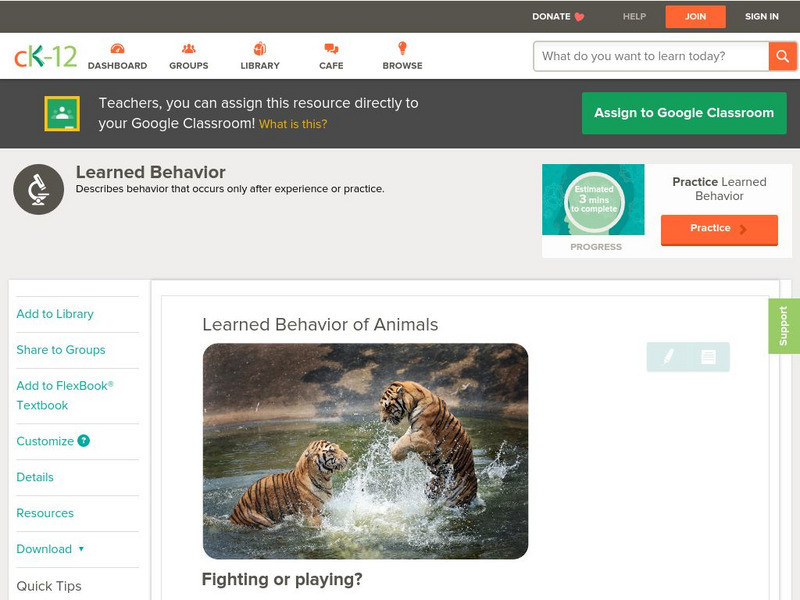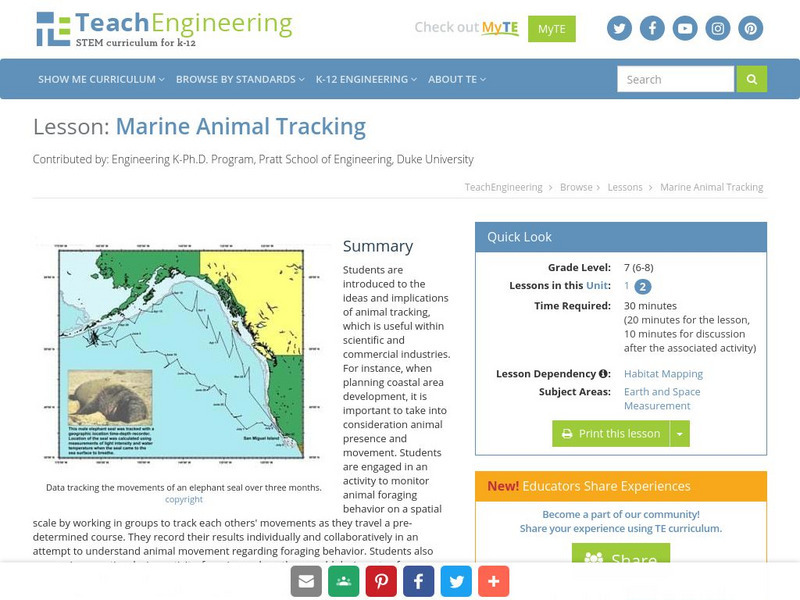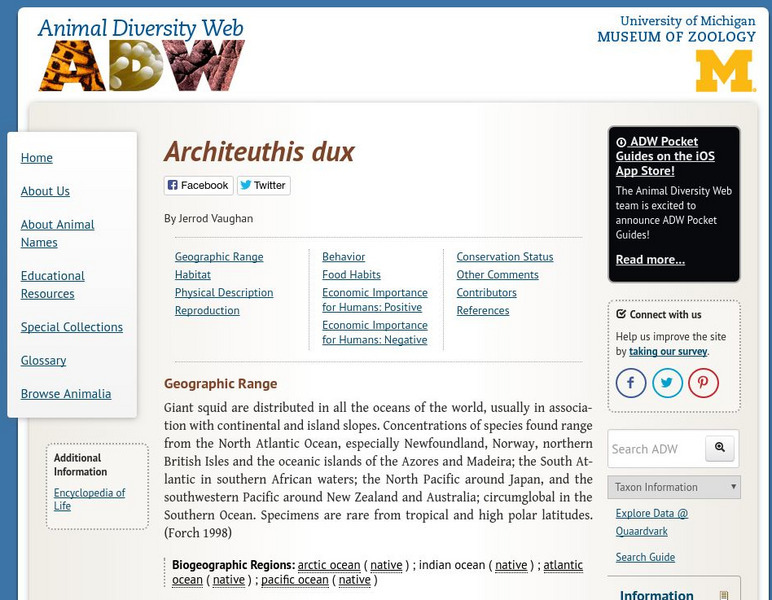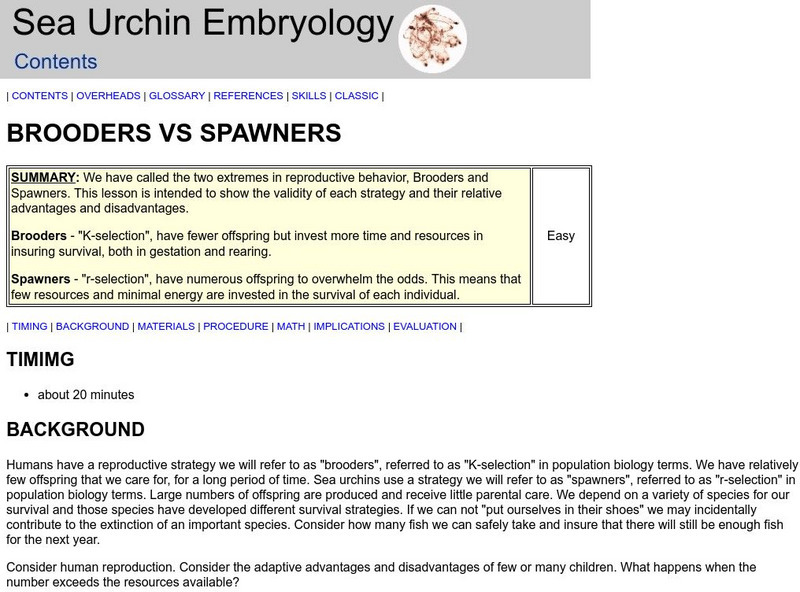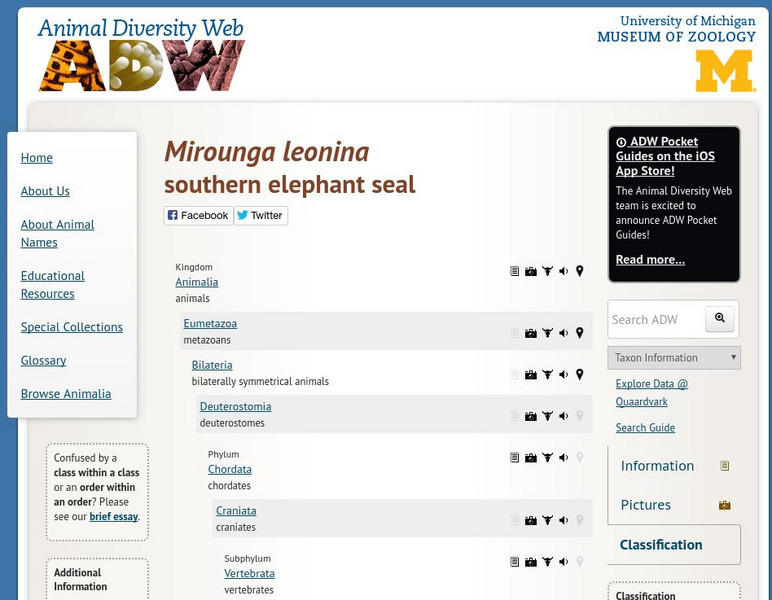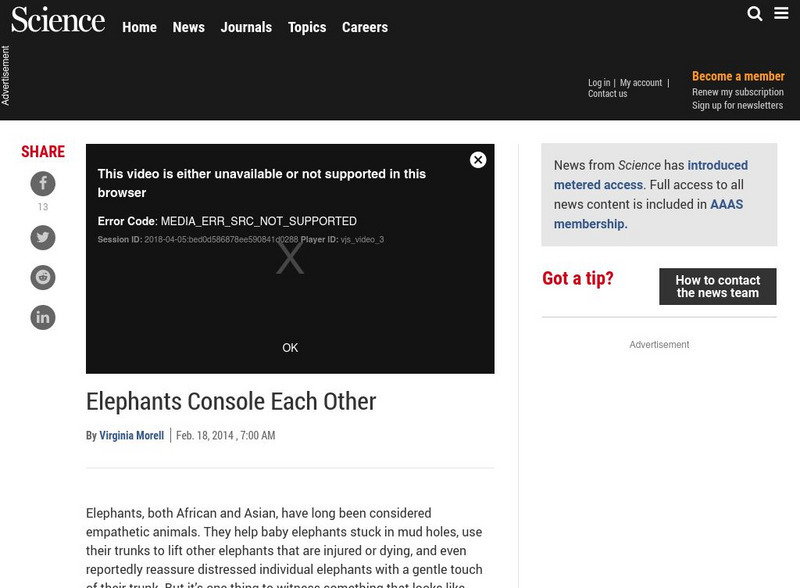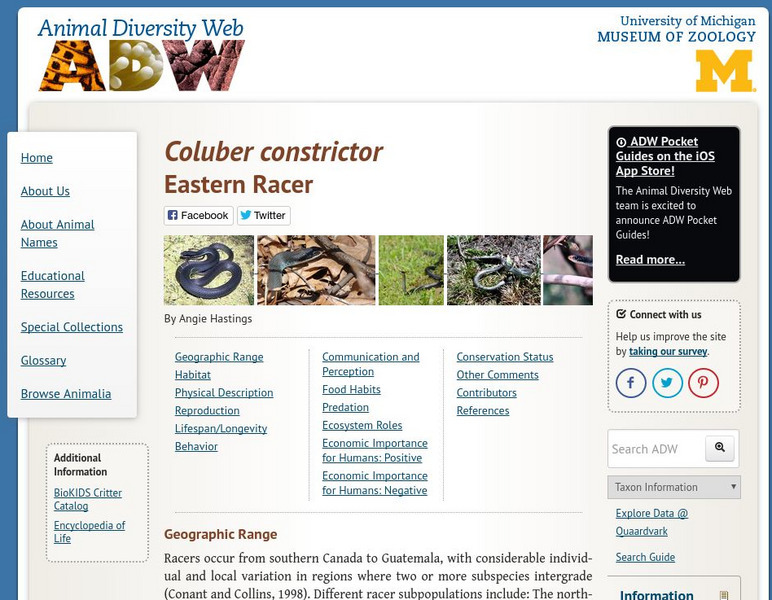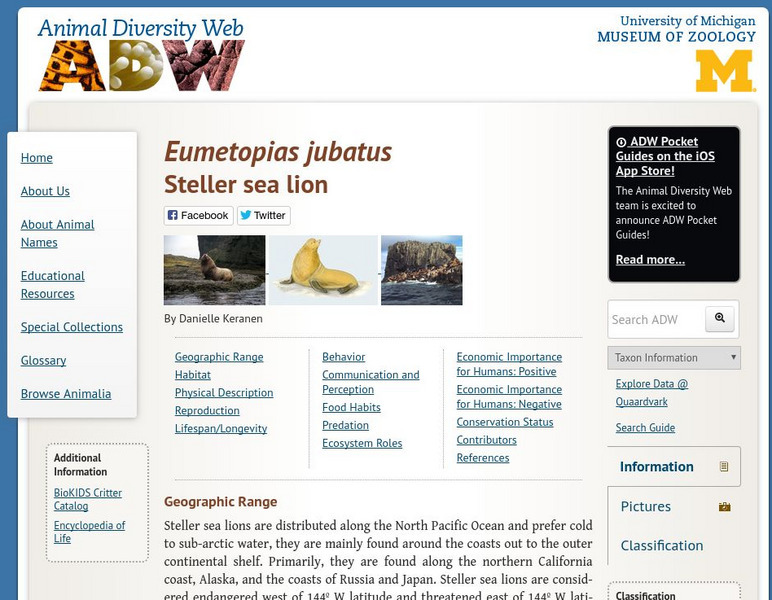CK-12 Foundation
Ck 12: Third Grade Science: Life Sci: Animal Characteristics and Classification
[Free Registration/Login may be required to access all resource tools.] Presents an overview of the major animals groups (mammals, birds, reptiles, amphibians, fish, arthropods, vertebrates, invertebrates, those having live births and...
CK-12 Foundation
Ck 12: Biology: Learned Behavior of Animals
[Free Registration/Login may be required to access all resource tools.] Describes types of behavior that animals can learn.
TeachEngineering
Teach Engineering: Marine Animal Tracking
This lesson engages young scholars in an activity to monitor animal foraging behavior on a spatial scale. The students will break into groups and track each other's movements as they move through a pre-determined course. The results will...
Regents of the University of Michigan
Animal Diversity Web: Giant Squid
The Animal Diversity Web provides a detailed overview of the giant squid. Content includes a focus on the giant squid's geographic range, habitat, physical description, reproduction, behavior, food habits, and more.
Stanford University
Stanford University: Brooders vs Spawners
A great explanation and hands-on activity to compare strategies of animal reproduction. Sea urchins and humans are compared.
ArtsNow
Arts Now Learning: Magic Rocks [Pdf]
In this lesson, students work in groups with each acting as a predator, prey, or family member in a particular habitat. They present their habitat performance to the class and students identify the habitat and animal relationships. Then,...
Regents of the University of Michigan
Animal Diversity Web: Gray Seal
A detailed site that focuses on geographic location, habitat, physical description, reproduction, behavior, diet, economic importance (positive/negative), and conservation status.
Regents of the University of Michigan
Animal Diversity Web: House Mouse
This complete site presents a wealth of information about the house mouse including topics such as habitat, physical description, reproduction, lifespan/longevity, behavior, communication, diet, predation, and more.
Regents of the University of Michigan
Animal Diversity Web: Southern Elephant Seal
Information on geographic range, habit, physical description, reproduction, lifespan, behavior, methods of communication, diet, predation, economic importance (positive/negative), and conservation status can be be found on this...
Science Buddies
Science Buddies: Tricks for Treats: How Long Does It Take to Train Your Pet?
Have you ever been to an animal show and seen a sea lion balance a ball on his nose, or a tiger jump through a hoop? Or maybe you've met dogs who can sit, fetch, shake, or beg on command. The range of tricks that you can teach animals is...
Regents of the University of Michigan
Animal Diversity Web: Cheetah (Acinonyx Jubatus)
In addition to providing detailed information about the cheetah, Animal Diversity Web also offers a wealth of pictures, specimens, and classification information for detailed study.
Other
Aaas Science News: Week of 2 24 14: Elephants Console Each Other
Article reports on findings from a recent study that elephants display empathy and console one another when upset. This behavior was previously thought to be unique to apes and humans. Includes a brief video [0 mins, 50 sec].
Physics Classroom
The Physics Classroom: Behavior of Waves
Boundary behavior, incident pulse, reflected pulse,and transmitted pulse are explained in this thorough tutorial. Animation and drawings are used to clarify the concepts.
Science Buddies
Science Buddies: Dog Toys: What Makes One a Favorite or a Flop to Fido?
It seems as though dogs, like people, have definite preferences for their play things. This fun project investigates what makes a toy interesting to a dog. In these experiments, you and your dog can have some fun while you learn about...
Regents of the University of Michigan
Animal Diversity Web: Eastern Racer
Detailed information about this snake including where it can be found, its physical features, diet, behavior, etc. are found on this site, along with some photos.
Regents of the University of Michigan
Animal Diversity Web: Steller Sea Lion
Comprehensive reference material on Steller's sea lion: its appearance, habitat, diet, behavior, reproduction, positive and negative economic significance for humans, and conservation status.
Regents of the University of Michigan
Animal Diversity Web: Greater Kudu
Comprehensive reference material on the greater kudu, an African mammal, with information about its appearance, habitat, diet, behavior, reproduction, and positive and negative economic importance for humans.
US Geological Survey
U.s. Geological Survey: Save Animal Tracks as Plaster Casts
Engage students in the outdoors by searching for fresh animal tracks and making molds of them. Then investigate which animal might have been there.
PBS
Pbs Teachers: Scientific American: Animal Einsteins: Thinking About Thinking
Investigate the work of ethologists - animal behaviorists - by observing an animal's behavior (alone and then in a group) for an extended period of time. Produce a scientific report of your observations.
PBS
Pbs Teachers: Scientific American: Animal Einsteins: Who Needs Words, Anyway?
Explore the theory that animals can learn to comprehend abstract concepts by observing to see if specific animal calls are associated with specific actions. Use scientific observation and record-keeping to collect and analyze data.
CK-12 Foundation
Ck 12: Life Science: 8.6 Reproductive Behavior
Understand different types of animal reproductive behavior.
CK-12 Foundation
Ck 12: Life Science: 8.3 Learned Behavior
Understand different types of learned behavior among animals and humans.
Animal Fact Guide
Animal Fact Guide: Greater One Horned Rhinoceros
Reference guide to the Greater One-horned Rhinoceros that features facts on its physical characteristics, habitat (with a distribution map), diet, breeding patterns, unique traits and behavior, conservation status, and tips on what you...
Animal Fact Guide
Animal Fact Guide: Mountain Gorilla
Learn interesting facts about the Mountain Gorilla including information on its physical characteristics, habitat (with a distribution map), diet, breeding patterns, unique traits and behavior, conservation status, and tips on what you...
Other popular searches
- Animal Behavior Experiments
- Wild Animal Behavior
- Animal Behavior in Termites
- Animal Behavior of Fish
- Domestic Animal Behavior
- Animal Behavior Lesson Plans
- Biology Animal Behavior
- Animal Behavior Labs
- Animal Behavior Lab Betta
- Dance and Animal Behaviors
- Animal Behaviors Betta
- Innate Behavior Animal



